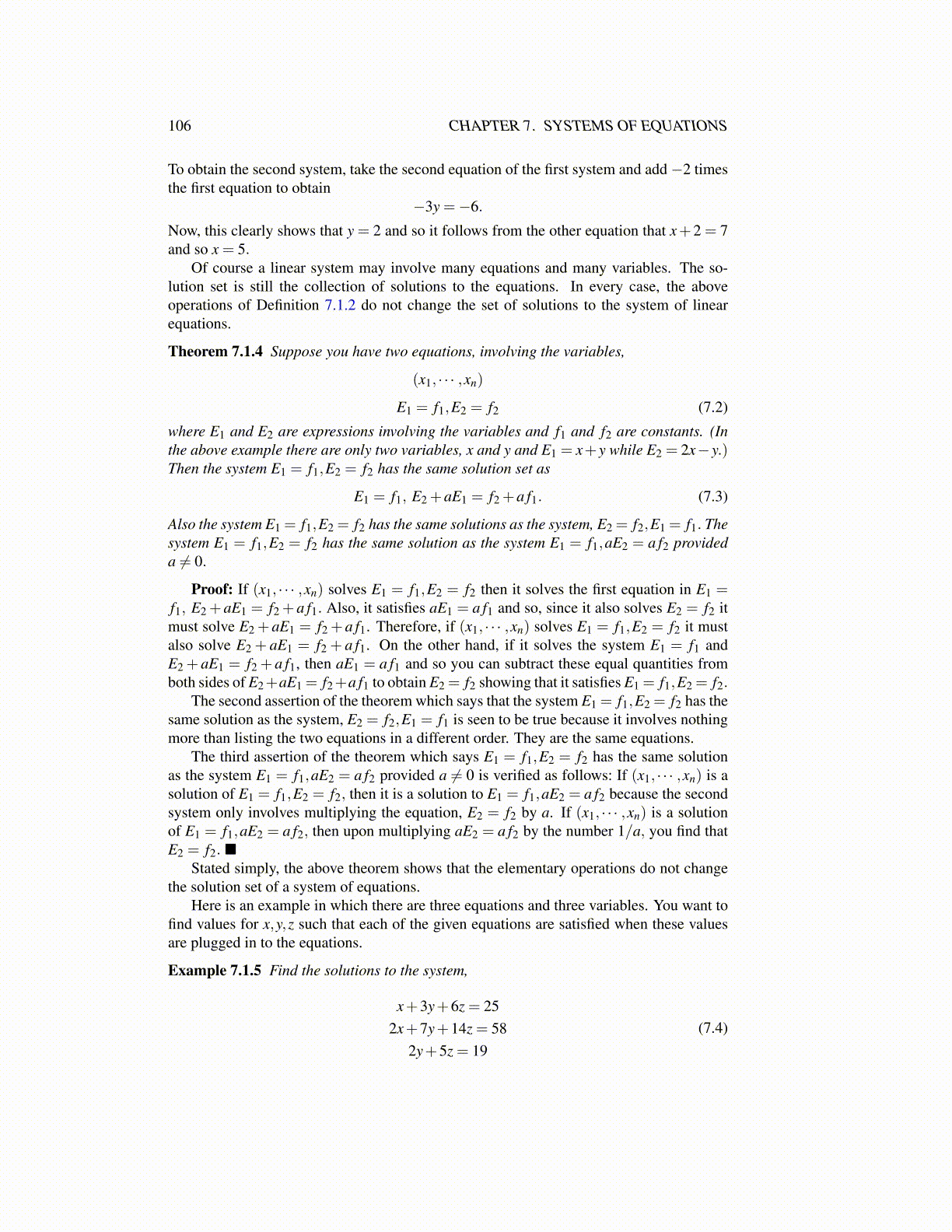
106 CHAPTER 7. SYSTEMS OF EQUATIONS
To obtain the second system, take the second equation of the first system and add −2 timesthe first equation to obtain
−3y =−6.
Now, this clearly shows that y = 2 and so it follows from the other equation that x+2 = 7and so x = 5.
Of course a linear system may involve many equations and many variables. The so-lution set is still the collection of solutions to the equations. In every case, the aboveoperations of Definition 7.1.2 do not change the set of solutions to the system of linearequations.
Theorem 7.1.4 Suppose you have two equations, involving the variables,
(x1, · · · ,xn)
E1 = f1,E2 = f2 (7.2)
where E1 and E2 are expressions involving the variables and f1 and f2 are constants. (Inthe above example there are only two variables, x and y and E1 = x+y while E2 = 2x−y.)Then the system E1 = f1,E2 = f2 has the same solution set as
E1 = f1, E2 +aE1 = f2 +a f1. (7.3)
Also the system E1 = f1,E2 = f2 has the same solutions as the system, E2 = f2,E1 = f1. Thesystem E1 = f1,E2 = f2 has the same solution as the system E1 = f1,aE2 = a f2 provideda ̸= 0.
Proof: If (x1, · · · ,xn) solves E1 = f1,E2 = f2 then it solves the first equation in E1 =f1, E2 +aE1 = f2 +a f1. Also, it satisfies aE1 = a f1 and so, since it also solves E2 = f2 itmust solve E2 +aE1 = f2 +a f1. Therefore, if (x1, · · · ,xn) solves E1 = f1,E2 = f2 it mustalso solve E2 + aE1 = f2 + a f1. On the other hand, if it solves the system E1 = f1 andE2 + aE1 = f2 + a f1, then aE1 = a f1 and so you can subtract these equal quantities fromboth sides of E2+aE1 = f2+a f1 to obtain E2 = f2 showing that it satisfies E1 = f1,E2 = f2.
The second assertion of the theorem which says that the system E1 = f1,E2 = f2 has thesame solution as the system, E2 = f2,E1 = f1 is seen to be true because it involves nothingmore than listing the two equations in a different order. They are the same equations.
The third assertion of the theorem which says E1 = f1,E2 = f2 has the same solutionas the system E1 = f1,aE2 = a f2 provided a ̸= 0 is verified as follows: If (x1, · · · ,xn) is asolution of E1 = f1,E2 = f2, then it is a solution to E1 = f1,aE2 = a f2 because the secondsystem only involves multiplying the equation, E2 = f2 by a. If (x1, · · · ,xn) is a solutionof E1 = f1,aE2 = a f2, then upon multiplying aE2 = a f2 by the number 1/a, you find thatE2 = f2. ■
Stated simply, the above theorem shows that the elementary operations do not changethe solution set of a system of equations.
Here is an example in which there are three equations and three variables. You want tofind values for x,y,z such that each of the given equations are satisfied when these valuesare plugged in to the equations.
Example 7.1.5 Find the solutions to the system,
x+3y+6z = 252x+7y+14z = 58
2y+5z = 19(7.4)